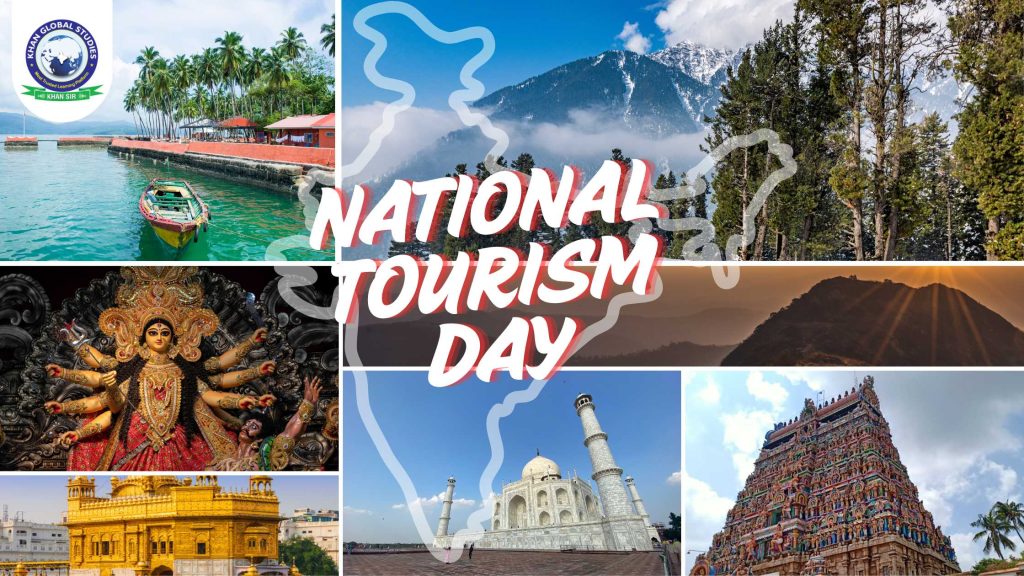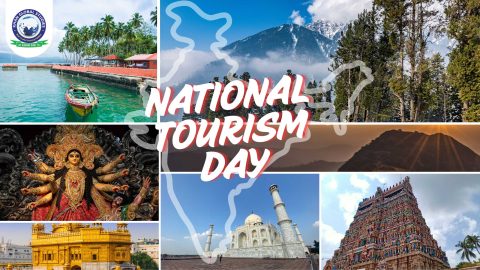Every year on January 25, India observes National Tourism Day to highlight the importance of tourism and promote the country’s rich cultural, historical, and natural heritage. This day serves as a significant opportunity to boost the tourism industry and raise awareness among the public about the value of tourism.
Importance of Tourism
Tourism is not only economically significant but also acts as a bridge connecting different societies and cultures.
- Economic Growth: The tourism sector contributes significantly to India’s GDP and provides employment to millions of people.
- Cultural Exchange: Tourism showcases India’s diverse and rich cultural heritage to the global audience.
- Local Development: It supports local businesses, such as handicrafts, traditional textiles, and culinary industries.
- Environmental Conservation: Tourism emphasizes the need to preserve natural sites and ecosystems.
India: A Treasure Trove of Tourism
India is globally renowned for its cultural, natural, and historical diversity. Every corner of this country offers something unique and extraordinary. Let’s explore some of India’s major tourist destinations that make it one of the most favored travel destinations in the world.
- Historical Sites: India’s history spans thousands of years, and the country is famous for its historical heritage:
- Taj Mahal (Agra): A symbol of love and a UNESCO World Heritage Site.
- Khajuraho Temples (Madhya Pradesh): Known for their exquisite architecture and intricate sculptures.
- Hampi (Karnataka): The ancient ruins of the Vijayanagara Empire.
- Qutub Minar (Delhi): The tallest brick minaret in the world.
- Amber Fort (Jaipur): A stunning example of royal Rajput architecture.
- Natural Beauty: Every region of India boasts breathtaking natural landscapes:
- Kashmir Valleys: Often referred to as “Paradise on Earth” for its unmatched beauty.
- Beaches of Goa: A perfect blend of sun, sand, and sea.
- Backwaters of Kerala: Serene and scenic waterways, also called “God’s Own Country.”
- Meghalaya’s Caves and Cherrapunji: A haven for nature lovers with lush greenery and abundant rainfall.
- Valley of Flowers (Uttarakhand): A vibrant landscape of colorful blossoms.
- Religious Sites: India’s religious diversity makes it a hub for spiritual tourism:
- Kashi (Varanasi): One of the oldest cities in the world, known for its sacred Ganges ghats.
- Ajmer Sharif (Rajasthan): The holy shrine of Khwaja Moinuddin Chishti.
- Golden Temple (Amritsar): A sacred place for Sikhs, renowned for its golden structure and serenity.
- Bodh Gaya (Bihar): The place where Lord Buddha attained enlightenment.
- Rameswaram (Tamil Nadu): One of the four sacred pilgrimage sites (Char Dham) in Hinduism.
- Folk Culture: India’s folk culture is its soul, reflected in its festivals and traditions:
- Fairs of Rajasthan: Pushkar Fair, Desert Festival, and Camel Fairs.
- Traditional Festivals of Northeast India: Nagaland’s Hornbill Festival and Mizoram’s Chapchar Kut.
- Durga Puja in West Bengal: A grand celebration of art, culture, and devotion.
- Baisakhi in Punjab: The harvest festival marked with joy and enthusiasm.
- Adventure Tourism: India offers numerous options for adventure enthusiasts:
- Trekking in Himachal Pradesh: Exciting trails in Kullu-Manali and Spiti Valley.
- Biking in Ladakh: A thrilling ride through Khardung La Pass and the Leh-Manali Highway.
- Scuba Diving in Andaman and Nicobar Islands: Explore the vibrant marine life and coral reefs.
- Mountaineering in Sikkim: Climbing the Kanchenjunga mountain range.
- River Rafting in Rishikesh: Experience the thrill of rafting in the Ganges.
- Beyond the Known
In addition to these destinations, there are countless other places in India where you can witness its unmatched beauty and rich heritage. Whether it’s the tranquil tea gardens of Darjeeling, the vibrant city life of Mumbai, or the serene deserts of Jaisalmer, India has something to offer every traveler.
India truly stands out as a land of unparalleled diversity, offering endless opportunities for exploration and discovery.
Challenges in the Tourism Sector
While tourism holds significant importance in India, there are several challenges that hinder its full development:
- Inadequate Infrastructure: Lack of proper roads, transportation facilities, and accommodations in many regions.
- Loss of Natural Heritage: Unregulated tourism often leads to environmental degradation and damage to natural sites.
- Safety and Cleanliness: Many tourist destinations face issues of hygiene and safety, impacting the overall visitor experience.
- Lack of Opportunities: Several lesser-known but beautiful tourist spots remain undiscovered due to insufficient promotion and recognition.
Purpose of National Tourism Day
The primary aim of celebrating National Tourism Day is to:
- Raise Awareness about Tourism: Educate the public, especially the youth, on the importance of tourism.
- Promote Local Culture: Highlight and support India’s local art, music, and traditions.
- Encourage Environmental Conservation: Foster responsibility toward the environment and promote sustainable tourism practices.
- Leverage Digital Platforms: Use modern digital technologies to make the tourism industry more effective and accessible.
Conclusion
India is a country whose diversity is unparalleled in the world. National Tourism Day inspires us to appreciate and preserve this richness. It also draws attention to strengthening the tourism industry and developing it in a sustainable and responsible manner.
“Tourism is not just about visiting places; it’s about living experiences and connecting with cultures.”





